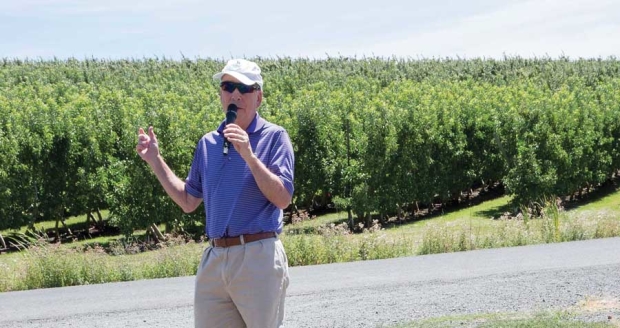
Despite the many challenges of growing Honeycrisp and the advent of many promising new varieties, Bruce Allen is still a big Honeycrisp fan.
“Everybody has a slightly different taste preference,” he acknowledged. “But, personally, I haven’t found anything that’s as good as a good Honeycrisp. There are a lot of varieties out there that probably have good eating quality, and they are probably more consistent than Honeycrisp. But Honeycrisp is in the marketplace. Everybody wants it. You don’t have to develop a marketing program to introduce your product.”
Allen’s Chiawana Orchard in Yakima was a stop on the International Fruit Tree Association’s summer tour in Washington.
Karen Lewis, Washington State University extension specialist, introduced Allen as a large Honeycrisp grower who has some of the oldest plantings in Washington and is also growing the variety in New Zealand.
“He’s absolutely passionate about everyone getting it right so that Honeycrisp is a fantastic eating experience every time, everywhere, regardless of where it’s grown,” Lewis said.
Allen, who also owns the packing company Columbia Reach in Yakima, said packouts ranged from 2 to 19 packs per bin at his warehouse last season. New, red strains of Honeycrisp—if they color better and more uniformly—might enhance the ability of a good grower to deliver a more consistent product to the marketplace, he believes.
“Right now, with standard Honeycrisp, unless you’re in Nova Scotia or New Zealand, your first pick looks pretty good, and your second pick may be OK, but you’ve got a fair bit of fruit out there where you struggle to get acceptable external color and you get to the point where that fruit is going to get overmature.”
Fruit not picked at the right maturity can develop stem splits and is prone to picking damage.
At Allen’s orchards, some of the fruit is sorted out during harvest. In a good season, 10 percent of the fruit might go on the ground, but other years it might be more than 20 percent, primarily because of stem bowl splits.
Allen said growers need to be cautious about planting more Honeycrisp because of the likelihood that prices will slip and quality expectations rise as volume increases. Washington produced 4.6 million boxes in 2013 and 6.6 million boxes last season.
“My guess is in the next two years we will be shipping 12 to 14 million boxes out of Washington, and we will get up to 20 million,” he said. “It’s going to be our No. 3 variety, I think, within five years. At 12 million, can you sell 36s and 48s? Can you sell the really low-colored second grade? If you’re only getting $35 a carton and 10 packs per bin and you’re only 55 bins per acre, I think there’s a lot of other things you could have planted that would give you a better gross return. But if you can do 18 packs and 100 bins, $35 is pretty good money.”
Rootstocks
Allen has tried both vertical and angled trellis systems and says he’s enamored with the multi-leader system on a precocious and vigorous rootstock, which is economical to plant and easy to manage.
“When you run the numbers on your tree cost per acre, if you get a Bibaum (biaxis) tree that fills the space of two M.9-size trees, you’ve cut your tree cost in half,” he observed. “Good growers can fill the canopy really quick.”
Allen said he tries every rootstock that comes out and then figures out which are vigorous and suitable for weak soils or replant sites. With Honeycrisp, he’s tried Malling Merton 106 (which developed phytophthora root rot), Geneva 11, 16, 41, 30, and 895.
Geneva 895 proved to be a vigorous but precocious rootstock. Although some people avoid G.16 because of its sensitivity to latent viruses, Allen said the trees in his four-acre planting on that rootstock look phenomenal. A block of G.30 on a replant site did extremely well, where other rootstocks didn’t perform. “They are out of control, vigorwise,” he said. “But they pump a lot of fruit out.”
Unless the rootstock is precocious, the trees will go into biennial bearing and won’t grow sustained yields year after year, he warned. “I’m just a firm believer that you have to identify the most precocious rootstock in terms of yield efficiency that will fill your canopy with your system.”
Color
Overtree cooling is used throughout the orchard to prevent sunburn. A block that the IFTA tour visited had Extenday reflective mulch on alternate rows to promote color development.
The block is planted on a slope and the mulch is not laid on the rows where the tractor drives uphill because it would otherwise damage the material.
Allen said he understands that Extenday in alternate rows provides about 70 percent of the benefit of a total treatment and at half the cost. Close to harvest, a mylar film is put down in rows without Extenday.
The objective of using Extenday is not to increase the amount of premium grade fruit, but to ensure that fruit picked for long-term storage has enough color at harvest and to increase the percentage of fruit in the first pick.
He measures pressure, starch, and Brix level to assess harvest maturity and has bought a DA meter to monitor maturity of the fruit on the tree.
“But my final rule of thumb is if it doesn’t taste good, you probably should not pick it,” he said. “And it should have some minimal color.” •
—by Geraldine Warner






Leave A Comment